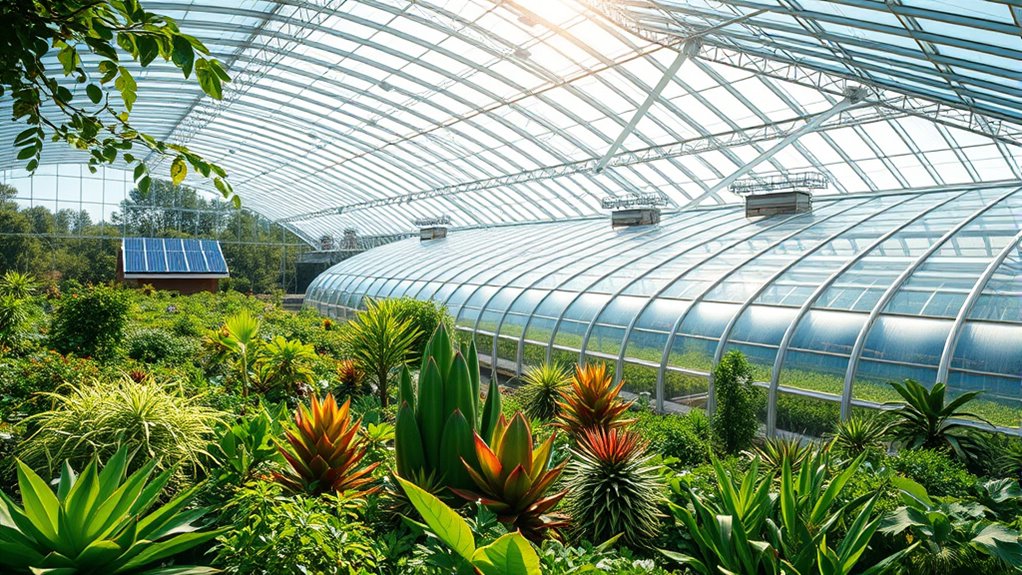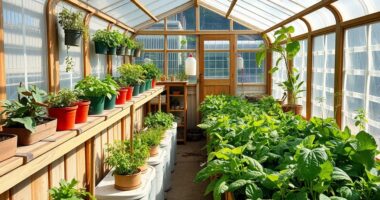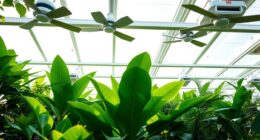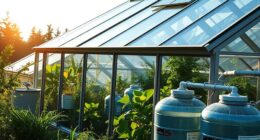Around the world, innovative greenhouse projects showcase sustainable design principles like natural lighting, ventilation, and rainwater harvesting to reduce energy and water use. They incorporate advanced materials such as low-emissivity glass and recycled framing, making structures more efficient and resilient to climate challenges. Regional adaptations include water-efficient cooling and insulation tailored to local environments. If you’d like to explore inspiring projects that demonstrate eco-friendly practices and technological breakthroughs, you’ll find plenty of ideas to spark your imagination.
Key Takeaways
- Showcases of eco-friendly greenhouses utilizing renewable energy, natural lighting, and rainwater harvesting for sustainable agriculture.
- Innovative structures using advanced glazing and recycled materials to enhance efficiency and climate resilience globally.
- Regional adaptations like water-efficient designs in arid zones and insulated cold-climate greenhouses for diverse environments.
- Projects demonstrating increased crop yields and reduced environmental impacts through eco-conscious design principles.
- Educational greenhouses integrating technology and visuals to promote awareness and inspire sustainable farming practices worldwide.
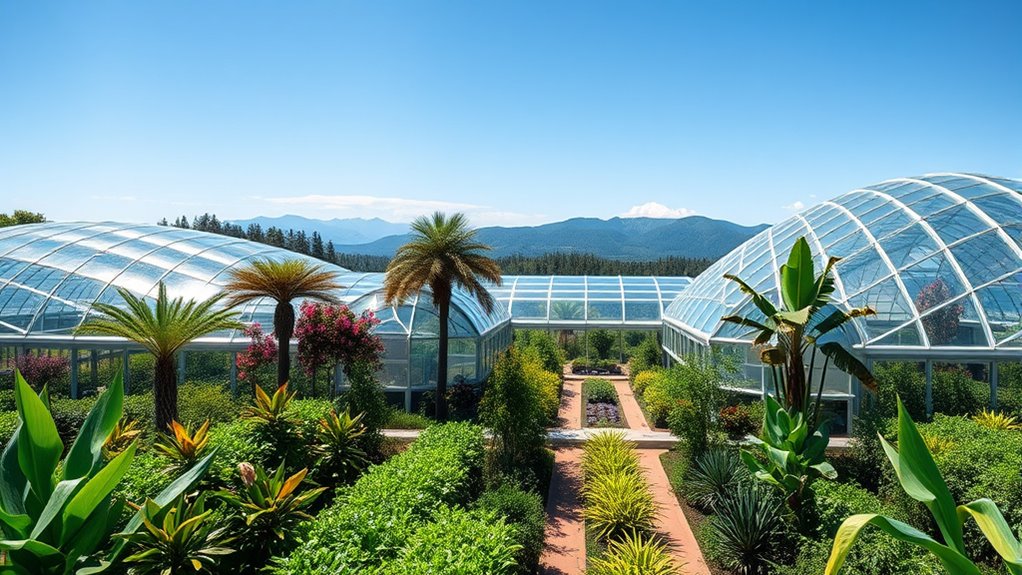
Have you ever wondered how greenhouses are transforming agriculture around the world? These structures are more than just glass enclosures—they’re hubs of innovation, blending sustainable design with cutting-edge materials to grow food more efficiently and responsibly. As you explore these projects, you’ll see how environmental consciousness and technological advancement come together to reshape farming practices on a global scale.
Many of today’s standout greenhouse projects prioritize sustainable design, ensuring they work harmoniously with their surroundings. Think about using natural lighting and ventilation systems that reduce energy consumption, or incorporating rainwater harvesting to minimize water waste. These greenhouses are intentionally built to lower their carbon footprint, often utilizing renewable energy sources like solar panels. By integrating sustainable design principles, they not only produce healthy crops but also serve as models for eco-friendly agriculture. They demonstrate how thoughtful planning and eco-conscious choices can lead to more resilient and efficient food production systems.
Innovative materials play a vital role in pushing these projects forward. You’ll find greenhouses constructed with advanced glazing techniques that maximize light transmission while insulating against heat loss. Materials like low-emissivity glass or polycarbonate sheets offer durability and better energy efficiency, allowing plants to thrive without excessive heating or cooling. Some projects experiment with biodegradable or recycled materials for framing, further reducing environmental impact. These innovative materials make it possible to design greenhouses that are lighter, stronger, and more adaptable to various climates. This not only improves crop yields but also extends the lifespan of the structures themselves. Additionally, the use of innovative materials can contribute to climate resilience by withstanding extreme weather conditions. Moreover, advances in sustainable construction materials are paving the way for more cost-effective and environmentally friendly greenhouse solutions. Incorporating advanced manufacturing techniques can also accelerate construction timelines and improve structural precision.
Across different regions, these greenhouses adapt to local conditions while maintaining a focus on sustainability. In arid areas, water-efficient designs and evaporative cooling systems are combined with innovative materials to create controlled environments that conserve resources. In colder climates, advanced insulation and energy-efficient glazing help maintain ideal temperatures with less energy. The use of innovative materials also facilitates rapid construction, allowing farmers to respond quickly to changing market demands or environmental conditions.
Ultimately, these inspiring greenhouse projects prove that sustainable design and innovative materials are key to future-proofing agriculture. They show that it’s possible to grow more food with less environmental impact, all while harnessing technology to improve efficiency. Additionally, integration of sound design principles in the development of these projects can enhance environmental awareness and community engagement through educational audio-visual content. As you witness these developments around the world, you can appreciate how each project pushes the boundaries of traditional farming, paving the way for a more sustainable and resilient food system for generations to come.
Frequently Asked Questions
What Are the Environmental Benefits of These Greenhouse Projects?
You’ll find that these greenhouse projects offer significant environmental benefits. They promote sustainable practices by reducing energy use and minimizing waste, which helps lower your carbon footprint. Additionally, they support biodiversity preservation by creating habitats for various plants and animals. By choosing eco-friendly materials and innovative designs, these projects demonstrate how greenhouses can positively impact the environment, encouraging more sustainable habits and protecting natural ecosystems for future generations.
How Do These Greenhouses Impact Local Communities Economically?
You’ll see that these greenhouses boost local economies through community development and job creation. They provide new employment opportunities, attracting workers and supporting local businesses. As a result, communities become more self-sufficient, and income levels rise. Plus, greenhouses often encourage skill development and entrepreneurship, fostering long-term economic growth. Overall, they help strengthen community ties while offering sustainable economic benefits.
What Innovative Technologies Are Used in These Global Greenhouse Projects?
Have you ever wondered what makes greenhouses truly innovative? In these projects, you’ll see cutting-edge technologies like hydroponic systems that grow plants without soil, boosting efficiency. Solar integration plays a crucial role by harnessing renewable energy to power climate control and lighting. These advancements not only optimize plant growth but also reduce environmental impact, showcasing how technology transforms agriculture into a sustainable, forward-thinking industry.
How Do Climate Conditions Influence Greenhouse Design Worldwide?
Climate conditions shape your greenhouse design strategies by demanding tailored adaptations. You’ll need climate adaptation techniques, like insulation for cold regions or shading for hot, sunny areas. These conditions influence your choice of materials, ventilation, and energy systems to optimize plant growth. By understanding local climate challenges, you can develop effective greenhouse designs that guarantee sustainability and productivity, no matter where you’re building around the world.
What Challenges Do Project Creators Face When Establishing Greenhouses Internationally?
You face numerous challenges when establishing greenhouses internationally. Customs regulations can delay equipment delivery by up to 50%, disrupting your project timeline. Supply chain issues, especially for specialized materials, add complexity and cost. Managing different countries’ policies requires patience and adaptability. These hurdles demand thorough planning and local partnerships to ensure your greenhouse project succeeds, despite these global logistical obstacles.
Conclusion
As you’ve seen, greenhouses range from simple backyard setups to towering, high-tech marvels. While some projects focus on sustainability, others push the boundaries of innovation. It’s fascinating how these structures, whether humble or grand, share a common goal: to nurture life and combat climate challenges. Just as a tiny seed can grow into a towering tree, even small changes in greenhouse design can lead to monumental impacts on our planet’s future.
